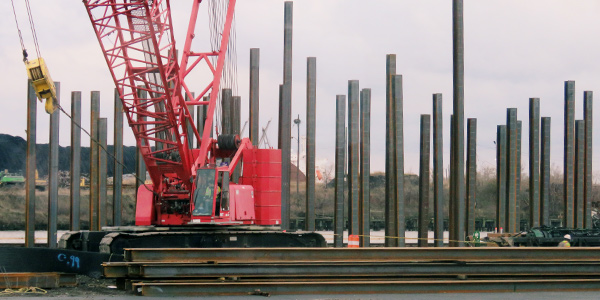By Rich Heidorn Jr.
Sparrows Point, Md. — New signs of life are emerging amid the rubble of what used to be the world’s largest iron and steel mill.
Tradepoint Atlantic, which is redeveloping the 3,300-acre site of the former Bethlehem Steel Sparrows Point, calls its project a “modern industrial revival.” But instead of manufacturing the skeletons of bridges, office buildings and warships on the site, Tradepoint Atlantic is building infrastructure for international trade and e-commerce.
With access to ship, rail and truck transportation, supported by the heavy industrial electrical and other utility services left from the steel mill, this “intermodal logistics hub” has already attracted Amazon and Baltimore-based Under Armour, which have neighboring warehouses totaling 2 million square feet. Home Depot and Floor & Decor are about to open even bigger distribution facilities nearby. And Volkswagen has leased 115 acres as a terminal to handle the import of 120,000 cars annually.
One place that will be doing at least some manufacturing is the 45-acre site Denmark-based Orsted is developing as a staging area for its 120-MW Skipjack offshore wind farm planned near the Maryland-Delaware border.
Sparrows Point is one of four ports being developed for OSW on the East Coast, with nine others under consideration, according to the Business Network for Offshore Wind.
Orsted, the world’s leading offshore wind developer with about one-quarter of world market share, is investing $38.2 million in Sparrows Point to satisfy the “local content” requirement Maryland regulators demanded in their contract to purchase Skipjack’s offshore renewable energy credits. Orsted also is making port investments in Rhode Island ($40 million in ProvPort and Quonset), Long Island (an operations and maintenance hub in Port Jefferson) and New London, Conn. ($57.5 million in a joint venture with Eversource Energy).
On Monday, Tradepoint and Orsted hosted an open house and tour for about 100 people — including local union officials, a state senator and former Bethlehem Steel workers — curious about the plans.
The visitors saw workers driving piles into the site of the “LoLo” (lift on, lift off) berth, where cranes will move heavy equipment. That is perpendicular to the “RoRo” (roll on, roll off) berth. The two comprise a 15-acre dockside operations area, which is designed to handle loads as heavy as 15 tons per square meter.
Adjacent to that will be a 115-acre manufacturing and “laydown” area, where the 351-foot turbine blades and even longer monopiles will be stored. The laydown area could grow, said Russell Williams, a Tradepoint business development associate who led the tour. “For the size and weight of the components for offshore wind, we need a lot of space and we need a lot of heavy [load-bearing capacity],” he said.
Orsted also will have access to the 1,200-by-200-feet dry dock, which could be used for assembling gravity-based turbine foundations.
For starters, much of the equipment for the windfarm — including the monopiles and blades — will be imported from Europe to Sparrows Point for assembly. Only the external platform, suspended internal platform (housing for electronics and switch gear), boat landings and anode cage, will be manufactured locally initially.
“Obviously, the long-term goal would be to manufacture [the blades and monopiles] here, but for the first round of projects that’s not really feasible,” said Zach Finucane, an Orsted manager of the project.
Using the Chesapeake & Delaware Canal as a shortcut to the Atlantic, Orsted’s staging facilities will be about 94 miles from Skipjack (which is in the federal government’s Delaware Wind Energy Area, although it will sell its output to Maryland ratepayers).
Growth Opportunities
The Atlantic Coast between Cape Hatteras, N.C., and Cape Cod, Mass., has seen the most interest from OSW developers in the U.S., due to its strong winds, the shallow waters of the continental shelf and its large, energy-hungry coastal population.
Brandon Burke, policy and outreach director for the Business Network, notes six states in the region — Massachusetts, Vermont, New York, New Jersey, Maryland and Virginia — have renewable portfolio standards of at least 50%. The region also will need capacity to replace retiring nuclear and coal plants, he noted.
Burke said state commitments exceed the capacity of the OSW leases the federal government has issued on the East Coast. “We are encouraging the federal government to issue additional leases, and we do see that coming, particularly in the New York Bight,” which stretches from the Cape May Inlet in New Jersey to Montauk Point on the eastern end of Long Island, he said.
Orsted hopes to win all the permits it needs for Skipjack by 2021, with installation beginning in 2022 and commercial operations later that year.
The new technology has resulted in a potential roadblock: The Maryland Public Service Commission announced last month it had opened a comment period on Skipjack and US Wind’s project in the state’s wind energy area after learning the turbines for both will be about 200 feet taller than originally planned.
PSC spokeswoman Tori Leonard said she could not speculate on what action, if any, the commission will take after reviewing the comments. She denied a report that the commission was reconsidering its orders granting the wind farms ratepayer subsidies, saying it was taken out of context.
Finucane said Orsted is optimistic the review will not delay its timeline. “Obviously there’s always risks [of delay] to any construction project. We’re hopeful that’s not going to be a showstopper.”









